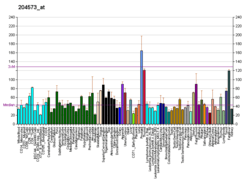CROT (gene)
Peroxisomal carnitine O-octanoyltransferase is an enzyme that in humans is encoded by the CROT gene.[5][6]
Carnitine octanoyltransferase (EC 2.3.1.137) is a carnitine acyltransferase that catalyzes the reversible transfer of fatty acyl groups between CoA and carnitine. This enzyme regulates the breakdown of Very Long Chain Fatty Acids (VLCFA) by performing a crucial step in the transport of medium length acyl chains out of the mammalian peroxisome to the cytosol and mitochondria for further breakdown. See also CRAT (MIM 600184). Van der Leij et al. (2000) reviewed the function, structural features, and phylogenetics of human carnitine acyltransferase genes, including CROT.[supplied by OMIM][6]
References
- 1 2 3 GRCh38: Ensembl release 89: ENSG00000005469 - Ensembl, May 2017
- 1 2 3 GRCm38: Ensembl release 89: ENSMUSG00000003623 - Ensembl, May 2017
- ↑ "Human PubMed Reference:".
- ↑ "Mouse PubMed Reference:".
- ↑ Ferdinandusse S, Mulders J, IJlst L, Denis S, Dacremont G, Waterham HR, Wanders RJ (Oct 1999). "Molecular cloning and expression of human carnitine octanoyltransferase: evidence for its role in the peroxisomal beta-oxidation of branched-chain fatty acids". Biochem Biophys Res Commun. 263 (1): 213–8. doi:10.1006/bbrc.1999.1340. PMID 10486279.
- 1 2 "Entrez Gene: CROT carnitine O-octanoyltransferase".
External links
- Human CROT genome location and CROT gene details page in the UCSC Genome Browser.
Further reading
- van der Leij FR, Huijkman NC, Boomsma C, et al. (2000). "Genomics of the human carnitine acyltransferase genes". Mol. Genet. Metab. 71 (1–2): 139–53. doi:10.1006/mgme.2000.3055. PMID 11001805.
- Gerhard DS, Wagner L, Feingold EA, et al. (2004). "The status, quality, and expansion of the NIH full-length cDNA project: the Mammalian Gene Collection (MGC)". Genome Res. 14 (10B): 2121–7. doi:10.1101/gr.2596504. PMC 528928. PMID 15489334.
- Scherer SW, Cheung J, MacDonald JR, et al. (2003). "Human chromosome 7: DNA sequence and biology". Science. 300 (5620): 767–72. doi:10.1126/science.1083423. PMC 2882961. PMID 12690205.
- Strausberg RL, Feingold EA, Grouse LH, et al. (2003). "Generation and initial analysis of more than 15,000 full-length human and mouse cDNA sequences". Proc. Natl. Acad. Sci. U.S.A. 99 (26): 16899–903. doi:10.1073/pnas.242603899. PMC 139241. PMID 12477932.
- Morillas M, Gómez-Puertas P, Rubí B, et al. (2002). "Structural model of a malonyl-CoA-binding site of carnitine octanoyltransferase and carnitine palmitoyltransferase I: mutational analysis of a malonyl-CoA affinity domain". J. Biol. Chem. 277 (13): 11473–80. doi:10.1074/jbc.M111628200. PMID 11790793.
- Yu W, Andersson B, Worley KC, et al. (1997). "Large-scale concatenation cDNA sequencing". Genome Res. 7 (4): 353–8. doi:10.1101/gr.7.4.353. PMC 139146. PMID 9110174.
- Andersson B, Wentland MA, Ricafrente JY, et al. (1996). "A "double adaptor" method for improved shotgun library construction". Anal. Biochem. 236 (1): 107–13. doi:10.1006/abio.1996.0138. PMID 8619474.
This article is issued from
Wikipedia.
The text is licensed under Creative Commons - Attribution - Sharealike.
Additional terms may apply for the media files.




